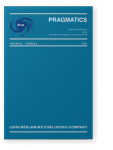Understandable public anger
Legitimation in banking after the 2008 crisis
In the ten years from 2008 onwards the banking sector was constantly in the spotlight. Blame for the financial crisis and concern regarding controversial government bailouts were followed by public outrage about inflated bonuses, money laundering and false reporting. Over this period, banks deployed a range of legitimation strategies to salvage their reputation. This paper proposes a modified typology of legitimation strategies based on previous research (van Leeuwen and Wodak 1999; Vaara, Tienari and Laurila 2006), and examines how these are used by in the “letter to shareholders” published by the chairs of the five main UK-based banks over the ten years following the crisis. The strategies are analysed in terms of their object, target and interdiscursive features, and the particular persuasive roles of narrative and emotion are underlined.
Article outline
- 1.Introduction
- 2.Theoretical framework: Legitimation strategies
- 3.Method
- 4.Findings
- 4.1Normalisation
- 4.2Authorisation
- 4.3Rationalisation
- 4.4Moralisation
- 4.4.1Claims to virtue
- 4.4.2Claiming solidarity and projecting empathy
- 4.5Mythopoesis
- 4.5.1Metaphor
- 4.5.2Re-narrativisations
- 4.5.3Future promise
- 4.6Overview of strategies
- 5.Discussion
-
References
References (29)
Abulof, Uriel
2015 “
Normative Concepts Analysis: Unpacking the Language of Legitimation.”
International Journal of Social Research Methodology 18 (1): 73–89.


Breeze, Ruth
2012 “
Legitimation in Corporate Discourse: Oil Corporations after Deepwater Horizon.”
Discourse & Society 23 (1): 3–18.


Basanta, Almudena, and Lieve Vangehuchten
2019 “
Las cartas de presentación en los informes de RSC en Chile, España y México” [“Introductory letters in CSR Reports in Chile, Spain and Mexico”].
Revista Ibérica 381: 99–126.

Brown, Penelope and Stephen Levinson
1987 Politeness: Some Universals in Language Use. Cambridge: Cambridge University Press.


Geppert, Mike
2003 “
Sensemaking and Politics in MNCs: A Comparative Analysis of Vocabularies within the Global Manufacturing Discourse in One Industrial Sector.”
Journal of Management Inquiry 121: 312–329.


Gergen, Kenneth, Mary Gergen, and Frank Barrett
2004 “
Dialogue: Life and Death of the Organization.” In
Handbook of Organizational Discourse, ed. by
David Grant,
Cynthia Hardy,
Cliff Oswick, and
Linda Putnam, 39–60. Thousand Oaks: Sage.


Giannarakis, Grigoris, and Ioannis Theotokas
2011 “
The Effect of Financial Crisis in Corporate Social Responsibility Performance.”
International Journal of Marketing Studies 3 (1): 2–10.


Habermas, Jürgen
1973 Legitimationsprobleme im Spätkapitalismus. Berlin: Suhrkamp.

Hargie, Owen, Karyn Stapleton, and Dennis Tourish
2010 “
Interpretations of CEO Public Apologies for the Banking Crisis: Attributions of Blame and Avoidance of Responsibility.”
Organization 17 (6): 721–742.


Hellín García, María José
Kostova, Tatiana, and Srilata Zaheer
1999 “
Organizational Legitimacy under Conditions of Complexity: The Case of the Multinational Enterprise.”
Academy of Management Review 241: 64–81.


Kress, Gunter, and Theo van Leeuwen
1996 Reading Images. The Grammar of Visual Design. London: Routledge.

Musolff, Andreas
2016 Political Metaphor Analysis. Discourse and Scenarios. London: Bloomsbury.

Orts, María Ángeles
2016 “
Power Distance and Persuasion: The Tension between Imposition and Legitimation in International Legal Genres.”
Journal of Pragmatics 921: 1–16.


Palazzo, Guido, and Andreas Georg Scherer
2006 “
Corporate Legitimacy as Deliberation: A Communicative Framework.”
Journal of Business Ethics 661: 71–88.


Poblete, Claudia
2011 “
Legitimation Strategies of the Deputies’ Discourse on the Constitutional Impeachment against the Education Minister of Chile.”
Revista Signos 44 (76): 168–182.

Reisigl, Martin, and Ruth Wodak
2016 “
The Discourse Historical Approach.” In
Methods of Critical Discourse Studies (3rd ed.), ed. by
Ruth Wodak and
Michael Meyer, 87–121. London: Sage.

Reisigl, Martin, and Ruth Wodak
2017 “
The Discourse-Historical Approach (DHA).” In
Routledge Handbook of Critical Discourse Studies, ed. by
John Flowerdew and
John E. Richardson, 44–59. London: Routledge.


Reyes, Antonio
2011 “
Strategies of Legitimization in Political Discourse: From Words to Actions.”
Discourse and Society 22 (6): 781–807.


Suchman, M.
(
1995) “
Managing Legitimacy: Strategic and Institutional Approaches.”
Academy of Management Review 20 (3): 571–610.


Vaara, Eero and Tienari, Janne
(
2008) “
A Discursive Perspective on Legitimation Strategies in MNCs.”
Academy of Management Review 331: 985–93.


Vaara, Eero, Janne Tienari, and Juha Laurila
2006 “
Pulp and Paper Fiction: On the Discursive Legitimation of Global Industrial Restructuring.”
Organization Studies 271: 789–810.


van Dijk, Teun
1998 Ideology: A Multidisciplinary Approach. London: Sage.

Van Dijk, Teun, and Luisa Martín Rojo
1997 “
‘There was a Problem, and it was Solved!’: Legitimating the Expulsion of ‘Illegal’ Migrants in Spanish Parliamentary Discourse.”
Discourse and Society 81: 523–566.


van Leeuwen, Theo
2007 “
Legitimation in Discourse and Communication.”
Discourse & Communication 1(1): 91–112.


van Leeuwen, Theo, and Ruth Wodak
1999 “
Legitimizing Immigration Control: A Discourse-Historical Perspective.”
Discourse Studies 11: 83–118.


Wodak, Ruth, and Meyer, Michael
2017 Methods of Critical Discourse Analysis (3rd ed.). London: Sage.

Zelditch, Morris
2001 “
Theories of Legitimacy.” In
The Psychology of Legitimacy: Emerging Perspectives on Ideology, Justice, and Intergroup Relations, ed. by
John Jost and
Brenda Major, 33–53. Cambridge: Cambridge University Press.

Cited by (2)
Cited by 2 other publications
Fernández-Vallejo, Ana María
2023.
Comunicar la sostenibilidad en las cadenas hoteleras españolas: el uso de las páginas web como herramienta de legitimación.
Doxa Comunicación. Revista Interdisciplinar de Estudios de Comunicación y Ciencias Sociales ► pp. 167 ff.

This list is based on CrossRef data as of 5 july 2024. Please note that it may not be complete. Sources presented here have been supplied by the respective publishers.
Any errors therein should be reported to them.
